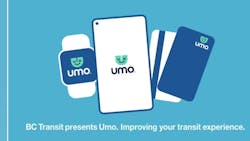Fare technology updates: NJ Transit, BCRTA, BC Transit
New Jersey Transit (NJ Transit) is enhancing the boarding process on its buses to become more effortless with “Tap, Scan, Ride” while Butler County Regional Transit Authority (BCRTA) is launching account-based ticketing (ABT) on its system via the EZfare app and BC Transit is implementing its Umo electronic fare system on two transit systems.
NJ Transit
NJ Transit is enhancing the boarding process on its buses to become more effortless with “Tap, Scan, Ride.” Beginning April 6, customers on all buses will scan their paper or mobile tickets at the onboard validator, reducing the time it takes to board. NJ Transit bus operators will no longer handle or validate printed or electronic tickets that contain a scannable barcode.
The agency notes customers will be required to scan all tickets and passes using the onboard validator or pay their fare upon boarding by tapping a contactless payment card or mobile device wallet or paying in cash. If a rider’s ticket does not have a printed barcode for scanning, the ticket should be presented to the bus operator for validation and collection.
As customers board the bus, a validator near the operator will display an image depicting scanning the barcode. Using barcoded paper and mobile tickets/passes, customers will scan the barcode of their ticket at the validator. The validator will turn green to confirm a valid ticket and the customer can proceed to ride. Customers can dispose of the ticket after arriving at their destination and do not have to provide it to the operator. Once a ticket has been scanned, it is no longer valid and cannot be used again. The validator will turn red when a previously used ticket is scanned and will not be valid for transportation. Customers using contactless payment will tap their card and then tell the operator how many zones they are traveling to make the payment.
There are no changes to the process for customers paying with cash.
BCRTA
The BCRTA has launched its new ABT system via the EZfare app. BCRTA becomes the fourth agency in Ohio to adopt the payment platform, following the Greater Cleveland Regional Transit Authority in Cleveland and Cincinnati Metro and Transit Authority of Northern Kentucky in Cincinnati.
With the introduction of ABT, CincyLink riders can now seamlessly navigate their journeys across the region by simply scanning the EZfare app when boarding the bus or utilizing the EZfare Smart Card for a quick tap-and-ride experience. The innovative system simplifies the travel process, eliminating the need to purchase tickets ahead of time.
One key feature of ABT is the implementation of monthly fare capping, a game-changer for CincyLink riders. Fare capping enables passengers to pay as they go and automatically transition to a monthly pass once they reach the equivalent cost, enhancing the rider’s experience and ensures fare equity for all passengers.
“Convenience and affordability should be at the core of public transit and the launch of ABT with fare capping will make CincyLink the premier way to commute from Butler County to Cincinnati,” said Shawn Cowan, director of customer care and public engagement at BCRTA.
The EZfare ticketing platform is the largest regional fare payment solution in the United States, encompassing 29 transit agencies across seven states.
BC Transit
BC Transit is implementing its Umo electronic fare system on its Prince George Regional Transit System and its Quesnel Regional Transit System.
New payment methods include the Umo Mobility app and a reloadable Umo card. The Umo Mobility app is free in the Apple App and Google Play stores. Once downloaded, riders create an account to purchase and manage their fare products. When ready to travel, riders open their app to display a QR code that serves as their fare product. As riders board the bus, they present their app’s QR code to a new onboard validator.
Riders alternatively have the choice of using a reloadable Umo card. A Umo card is available for free from a BC Transit Umo vendor. The card is designed for repeated use and can be continually topped up with fare products through a vendor, online or through Umo’s customer service call center. When boarding, riders tap their card at the new onboard validator. Riders are recommended to register their card by creating a Umo account online or through the Umo customer service call centre using the unique number on the back of their card. Registering a Umo card will safeguard fare products in the event a card is misplaced.
Umo introduces improvements and changes to some of the fare products riders use for both transit systems, including:
- Cash Balance: An alternative to cash and tickets, Cash Balance is a pre-deposited dollar amount loaded to a Umo card or app. A Cash Balance is drawn from as riders take trips or purchase a pass product. Riders paying with a Cash Balance will have their fare capped and automatically converted to a digital DayPASS after payment on their second trip of the day.
- A digital DayPASS now provides riders using a Umo payment method unlimited daily travel. A rider will know a digital DayPASS has been applied to their Umo payment method by referencing a confirmation message on the onboard validator’s digital screen. Riders are still able to purchase a paper DayPASS on board with cash or two tickets.
- A 30-Day Pass, eventually replacing the existing Monthly Pass, can be activated on any day of the month and provides riders with unlimited trips during a continuous 30-day period. A 30-Day Pass activates on first use, not when purchased. The final date for Monthly Pass product sales is still to be confirmed but BC Transit plans to provide riders several months to convert to the 30-Day Pass.
The Quesnel Regional Transit System is also offering a digital transfer, removing the need to collect and retain paper transfer slips that is automatically applied to a Umo app or card at onboard validation. Riders then simply scan or tap their Umo payment method on their second bus within a 90-minute transfer window to continue to travel without incurring an additional charge. A rider will know their transfer has been applied by referencing a confirmation message on the onboard validator’s digital screen. The system is also offering Digital 10 Rides, eventually replacing paper tickets, and is available via Umo.

Brandon Lewis | Associate Editor
Brandon Lewis is a recent graduate of Kent State University with a bachelor’s degree in journalism. Lewis is a former freelance editorial assistant at Vehicle Service Pros in Endeavor Business Media’s Vehicle Repair Group. Lewis brings his knowledge of web managing, copyediting and SEO practices to Mass Transit Magazine as an associate editor. He is also a co-host of the Infrastructure Technology Podcast.




